Brain hemorrhage also known as a brain bleed or an intracranial hemorrhage, refers to a life-threatening health condition in which blood vessel ruptures and causes bleeding inside or over the surface of brain. Some of the causes of brain hemorrhage include head trauma, aneurysm (swelling of artery due to weakening of artery wall), hypertension, congenital blood vessel abnormalities, brain tumor, drug abuse, bleeding disorders such as hemophilia and sickle cell anemia, and others. Brain hemorrhage is commonly associated with symptoms such as sudden severe headache, nausea, tingling or numbness, lethargy, loss of coordination, seizures with no previous medical history, changes in vision, loss of consciousness, difficulty in speaking, weakness in a limb, loss of balance, and others. Brain hemorrhage can be classified into three types based on the site of bleeding, i.e. intracerebral hemorrhage, subarachnoid hemorrhage and subdural hemorrhage. In case of intracerebral hemorrhage, the bleeding occurs inside the brain. In case of subarachnoid hemorrhage, the bleeding occurs between the brain and the membranes that cover it while in case of subdural hemorrhage, the bleeding happens below the inner layer of the dura (a membrane surrounding the brain) and above the brain. In case of epidural hemorrhage, bleeding occurs between the skull and the brain.
The global brain hemorrhage market is estimated to be valued at US$ 179.8 million in 2021 and is expected to exhibit a CAGR of 6.0% over the forecast period (2021-2028).
Figure 1. Global Brain Hemorrhage Market Share (%), By Region, 2021

To learn more about this report, Download Free Sample
The increasing incidence of risk factors associated with brain hemorrhage such as head injury, high blood pressure, brain tumor, aneurysm, and others is expected to drive the growth of the global brain hemorrhage market over the forecast period.
For instance, according to data provided by the National Center for Biotechnology Information in August 2021, it has been stated that the global prevalence of cerebral aneurysms (weakening of artery in brain) is approximately 3.2% while the risk of rupture causing subarachnoid hemorrhage is about 10 per 100,000 cases. The same source states that the prevalence of cerebral aneurysms increases in females after the age of 50 due to decreased levels of estrogen, which leads to reduced collagen in the vascular tissue, causing the weakening of blood vessels walls.
Brain Hemorrhage Market Report Coverage
| Report Coverage | Details | ||
|---|---|---|---|
| Base Year: | 2020 | Market Size in 2021: | US$ 179.8 Mn |
| Historical Data for: | 2017 to 2020 | Forecast Period: | 2021 to 2028 |
| Forecast Period 2021 to 2028 CAGR: | 6.0% | 2028 Value Projection: | US$ 270.3 Mn |
| Geographies covered: |
|
||
| Segments covered: |
|
||
| Companies covered: |
Baxter, Oxurion NV, Pfizer, Inc., F. Hoffmann-La Roche Ltd., Boehringer Ingelheim, Novartis AG, Bayer AG, Abbott, Bristol-Myers Squibb, Johnson and Johnson, Neurotech Pharmaceuticals, Inc., Siemens Healthcare GmbH, Novo Nordisk A/S, H. Lundbeck A/S, and Ligand Pharmaceuticals Incorporated |
||
| Growth Drivers: |
|
||
| Restraints & Challenges: |
|
||
Uncover macros and micros vetted on 75+ parameters: Get instant access to report
Figure 2. Global Brain Hemorrhage Market Value (US$ Mn), By Drug Type, 2021

To learn more about this report, Download Free Sample
The increasing research and development activities for the development of novel therapeutics for the treatment of brain hemorrhage is expected to drive the market growth over the forecast period.
Key players operating in the market are focusing on research and development activities for developing novel techniques and drugs for treatment of brain hemorrhage, which is expected to drive growth of the global brain hemorrhage market over the forecast period.
For instance, in February 2018, Penumbra Inc., a U.S. based medical device company initiated randomized clinical trials for checking the efficiency of its Artemis neuro evacuation device which is a minimally invasive technique used to clear out hematomas (mass of blood) in case of brain hemorrhage. This clinical trial comprises of 500 participants and is expected to be completed by July 2025.
Global Brain Hemorrhage Market – Impact of Coronavirus (Covid-19) Pandemic
Coronavirus (COVID-19) outbreak was first reported on December 31, 2019, in Wuhan, China. The World Health Organization declared COVID-19, as pandemic on March 11, 2020. According to the Coronavirus (COVID-19) Weekly Epidemiological Update by the World Health Organization, over 227,940,972 cases and 4,682,899 deaths due to coronavirus (COVID-19) were reported till September 19, 2021, across the globe.
The COVID-19 pandemic and lockdown in various countries across the globe has negatively impacted the financial status of businesses across all sectors. The COVID-19 pandemic has impacted the entire supply chain of the healthcare industry mainly due to strict lockdown in several regions. Likewise, COVID-19 pandemic is expected to have a negative impact on the global brain hemorrhage market in this, as recent research studies have found out that there is no direct correlation between brain hemorrhage and COVID-19.
According to a research study published by the Stroke medical journal in June 2021, only 48 (0.2%) COVID-19 patients out of 21,483 COVID-19 patients reported intracerebral hemorrhage. Out of these 48 COVID-19 patients, 26 patients were diagnosed for COVID-19 before having intracerebral hemorrhage, 10 patients were diagnosed for COVID-19 on the same day of incidence of intracerebral hemorrhage and six patients were diagnosed for COVID-19 during hospitalization for intracerebral hemorrhage. This study concludes that intracerebral hemorrhage is rare in COVID-19 patients and is not directly related to occurrence of COVID-19.
Global Brain Hemorrhage Market Restraint
Complications associated with the treatment of brain hemorrhage is the major factor that is expected to hinder growth of the global brain hemorrhage market over the forecast period. For instance, according to an article published by the British Medical Journal in March 2021, it has been found out that use of coagulation factors in the treatment of intracerebral hemorrhage leads to high risk of thromboembolic complications, i.e. formation of blood clot in the vein which then travels in the blood.
Key Players
Major players operating in the global brain hemorrhage market include Baxter, Oxurion NV, Pfizer, Inc., F. Hoffmann-La Roche Ltd., Boehringer Ingelheim, Novartis AG, Bayer AG, Abbott, Bristol-Myers Squibb, Johnson and Johnson, Neurotech Pharmaceuticals, Inc., Siemens Healthcare GmbH, Novo Nordisk A/S, H. Lundbeck A/S, and Ligand Pharmaceuticals Incorporated
Share
Share
Missing comfort of reading report in your local language? Find your preferred language :
Transform your Strategy with Exclusive Trending Reports :
Frequently Asked Questions
Select a License Type
Joining thousands of companies around the world committed to making the Excellent Business Solutions.
View All Our Clients